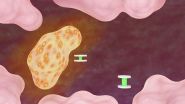To date, most efforts to image highly localized biochemical conditions such as abnormal pH* and ion concentration--critical markers for many disorders--rely on various nanosensors that are probed using light at optical frequencies. But the sensitivity and resolution of the resulting optical signals decrease rapidly with increasing depth into the body. That has limited most applications to less obscured, more optically accessible regions.
The new shape-shifting probe devices, described online in the journal Nature,** are not subject to those limitations. They make it possible to detect and measure localized conditions on the molecular scale deep within tissues, and to observe how they change in real time.
"Our design is based on completely different operating principles," says NIST's Gary Zabow, who led the research with NIH colleagues Stephen Dodd and Alan Koretsky. "Instead of optically based sensing, the shape-changing probes are designed to operate in the radio frequency (RF) spectrum, specifically to be detectable with standard nuclear magnetic resonance (NMR) or magnetic resonance imaging (MRI) equipment. In these RF ranges, signals are, for example, not appreciably weakened by intervening biological materials."
As a result, they can get strong, distinctive signals from very small dimensions at substantial depths or in other locations impossible to probe with optically based sensors.
The novel devices, called geometrically encoded magnetic sensors (GEMs), are microengineered metal-gel sandwiches about 5 to 10 times smaller than a single red blood cell, one of the smallest human cells. Each consists of two separate magnetic disks that range from 0.5 to 2 micrometers (millionths of a meter) in diameter and are just tens of nanometers (billionths of a meter) thick. (See animation.)
Between the disks is a spacer layer of hydrogel,*** a polymer network that can absorb water and expand significantly; the amount of expansion depends on the chemical properties of the gel and the environment around it. Conversely, it can also shrink in response to changing local conditions. Swelling or shrinking of the gel changes the distance (and hence, the magnetic field strength) between the two disks, and that, in turn, changes the frequency at which the protons in water molecules around and inside the gel resonate in response to radio-frequency radiation. Scanning the sample with a range of frequencies quickly identifies the current shape of the nanoprobes, effectively measuring the remote conditions through the changes in resonance frequencies caused by the shape-changing agents.
In the experiments reported in Nature, the scientists tested the sensors in solutions of varying pH, in solutions with ion concentration gradients, and in a liquid growth medium containing living canine kidney cells as their metabolism went from normal to nonfunctional in the absence of oxygen. That phenomenon caused the growth medium to acidify, and the change over time was sensed by the GEMs and recorded through real-time shifting in resonant frequencies. Even for the un-optimized, first-generation probes used, the frequency shifts resulting from changes in pH were easily resolvable and orders of magnitude larger than any equivalent frequency shifting observed through traditional magnetic resonance spectroscopy approaches.
Tracking highly localized pH values in living organisms can be difficult. (A blood test cannot necessarily do it because the sample mixes blood from numerous locations.) Yet local pH changes can provide invaluable early signals of many pathologies. For example, the pH around a cancer cell is slightly lower than normal, and internal inflammation generally leads to local change in pH level. Detecting such changes might reveal, for example, the presence of an unseen tumor or show whether an infection has developed around a surgical implant.
"Of course, that sort of potential use in living organisms is still a long way off," Zabow said. "Our data were taken in vitro. And some potential applications of the sensors may not be biological at all. But a long-term goal is to improve our techniques to the point at which GEMs can be employed for biomedical uses."
That would require, among other things, further miniaturization. The 0.5 to 2 µm diameter GEMs in the experiments are already small enough for many in vitro and other possible non-biological applications, as well as possibly for some in vivo cellular related applications. But preliminary estimates by the experimenters indicate that the sensors can be reduced substantially from their current size, and might conceivably be made smaller than 100 nanometers in diameter. That would open up many additional biomedical applications.
One of the most significant features of GEMs is that they can be "tuned" in fabrication to respond to different biochemical states and to resonate in different parts of the RF spectrum by altering the gel composition and the magnet shapes and materials, respectively. So placing two different populations of GEMs at the same site makes it possible to track changes in two different variables at the same time--a capability the researchers demonstrated by placing GEMs with two different dimensions in the same location and detecting the signals from both simultaneously.
"The idea is that you could design different sensors to measure different things, effectively measuring a panel of potential biomarkers simultaneously, rather than just one, to better differentiate between different pathologies," Zabow says. "We think that these sensors can potentially be adapted to measure a variety of different biomarkers, possibly including things such as glucose, local temperatures, various ion concentrations, possibly the presence or absence of various enzymes and so forth."
Ron Goldfarb, leader of NIST's Magnetics Group, notes that, "the work on geometrically encoded magnetic sensors by Gary Zabow and colleagues is a natural extension of research published by the team, along with NIST's John Moreland, in 2008. That work showed how micromagnets can act as 'smart tags' to potentially identify particular cells, tissues or physiological conditions. Functionally, the GEMS in the current effort are more advanced in that they change their shape in response to stimuli; thus, they act as measurement devices. The next challenge will be design optimization and the development of dimensionally controlled, large-scale fabrication processes in order to make these sensors widely available to researchers."
INFORMATION:
* pH is a measure of the acidity or alkalinity of a substance, on a scale ranging from 0 (highly acidic) to 14 (highly alkaline). 7 is neutral. Human blood is normally around 7.4.
** G. Zabow, S.J. Dodd and A.P. Koretsky. Shape-changing magnetic assemblies as high-sensitivity NMR-readable nanoprobes. Nature, Published online March 16, 2015.doi:10.1038/nature14294.
*** Hydrogels are cross-linked networks of polymers that can absorb various amounts of water depending on their chemical composition and structure. The hydrogels used in the NIST-NIH project were engineered to swell in neutral environments and to shrink in low-pH environments.


